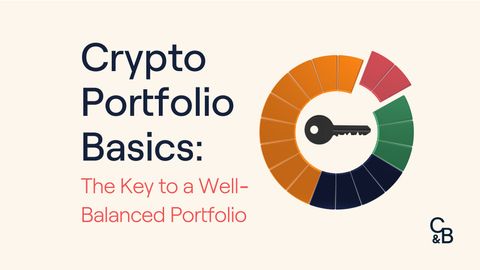Key Points
- A concentrated crypto portfolio only has one or a few assets, which can be a riskier approach,but it also presents greater potential for higher returns.
- A diverse crypto portfolio distributes risk across multiple crypto assets that are not strongly correlated with each other, potentially reducing the impact of market volatility.
- A well-balanced crypto portfolio includes assets across different market sectors, with varying market caps, and various use cases.
Bitcoin and Ethereum are all you need, right? It depends.
While some investors prefer to buy and hold the largest cryptocurrencies, others may turn to altcoins or stablecoins.
But which strategy is best?
While there isn't a single portfolio that suits every investor, if you want to maximise your return while minimising your risk, a good starting point is a diversified and well-balanced crypto portfolio.
Don't know where to start? Read on as we break down how to build a well-balanced crypto portfolio.
What is a Crypto Portfolio?
A crypto investment portfolio is a basket of cryptocurrencies.
It's similar to a traditional investment portfolio, except you’re sticking to one asset class (cryptocurrency) rather than a combination of stocks, real estate and bonds.
Crypto Portfolio Building Basics
The primary goal of building a well-balanced portfolio is to minimise the impact of market volatility by managing risk through diversification.
Creating a well-balanced crypto portfolio by diversifying the assets you invest in can significantly reduce your exposure to risk while increasing exposure to a broader range of digital assets.
There is no one-size-fits-all approach to building a portfolio, and each strategy comes with different trade-offs for different types of traders or investors, depending on their goals, risk appetite and profile. Essentially, your ability to accept potential losses or large fluctuations in unrealised gains or losses could provide higher returns in the long term.
Concentrated vs Diversified Crypto Portfolios
There are two main strategies for constructing a crypto portfolio: building a concentrated portfolio or a highly diversified portfolio. Each approach comes with trade-offs that you should consider.
Concentrated
A concentrated portfolio holds only a few assets. Holding a select number of assets can generate higher returns if those assets prove to perform well over periods of time. However, picking winning assets is no easy feat and requires much more skill, and often luck. The probability of picking high performers reduces with the lower number of assets you have exposure to. Moreover, with a potential for high reward comes an equal potential for high risk.
Concentrated portfolios can be much more susceptible to volatility and carry considerable risk, as every little change in market sentiment can have ripple effects on your portfolio, which can be amplified if your holdings are in more volatile assets such as small caps. They also create a concentration of risk and larger downside exposure if an investor is allocated to only one or a few assets in similar sectors of the crypto market. Overexposure to a single protocol and the assets that live in that ecosystem can put investors at risk if something goes wrong, as seen in the Terra LUNA fiascocollapse.
Diversified
A diverse portfolio holds various crypto assets, usually across multiple sectors or protocols. Holding a variety of assets helps the investor mitigate market risk since not all of their eggs are concentrated in one basket. The structure of these portfolios also tends to be better fortified against market volatility. If the price of one asset drops significantly, the assets unaffected by the price drop can help offset or minimise any losses. This logic guides equities investors who amend the weight of their portfolio allocated to defensive, cyclical and sensitive companies/sectors – each acting differently in certain market conditions.
Diversified portfolios distribute volatility and risk as they mirror trends across the market. As a result, the performance of this portfolio may not go up or down as rapidly as more concentrated portfolios. This can safeguard against extreme negative price performance and risk.
For beginner investors, diversified portfolios tend to give greater balance and less volatility compared to concentrated portfolios. It’s why many invest in traditional markets via the S&P 500, where their wealth is shared across a large number of companies. If one falls, the hit won’t be as significant if that same company made up one of ten in a narrower portfolio. It’s important to note the exception to these principles. Periods with significant news, geopolitical, and macroeconomic developments can impact the entire market, causing many assets to make significant gains or pull back as investors sell. For example, as President Trump has announced tariffs throughout his second term in 2025, any shocks that have caused risk-off sentiment have seen a broad sell-off across risk assets, including crypto. In these cases, the value of your crypto portfolio would likely decline regardless of the assets you hold as broader short-term sentiment becomes bearish.
How to Build a well balanced portfolio
The following points can help you formulate your own decisions when building out your crypto portfolio.
Diversify Risk (To a Point)
Diversification is great for balancing your portfolio. But over-diversification can lead to a portfolio that essentially mirrors the market. Gains and losses can continually cancel each other out, so it’s important to diversify without compromising long-term portfolio growth.
These three tips can help you diversify your portfolio:
Invest in assets with different risk profiles:Distribute your investments across large, medium, and small-cap crypto assets and allocate them appropriately. Generally, the lower the market cap, the higher the risk. Your risk profile will determine what's best for you, but consider striking a balance between each category. You can check crypto asset market caps at CoinGecko or CoinMarketCap.
Pick the right number of assets: While there is no magic number that tips the scales of diversification, if you’re unable to stay up to date with important movements, updates and news for each of your assets, then you might have one too many in your portfolio. Warren Buffett’s mentor, Benjamin Graham, recommends investors have a portfolio with 10 to 30 stocks, which is considered adequate diversification. While that applies to equities, it can easily apply to crypto, too.
Allocate across different types of assets/sectors: Selecting assets with varying use cases across different crypto sectors or protocols is an effective way to manage risk. If one sector faces a downturn, investments in another sector may help offset losses. For example, if the DeFi sector experiences a sell-off and your investment in a small or mid-cap project is affected, holding longstanding large-cap coins, such as bitcoin, could stabilise your overall portfolio. This diversification can help you maintain your position until market conditions improve.
Include Stablecoins
Allocating a portion of your portfolio to Stablecoins can help provide liquidity for your portfolio. Having stablecoins sitting on the sidelines can provide you with the ammunition to quickly and easily take advantage of market opportunities as they arise.
One of the many benefits of trading with Caleb & Brown is the availability of unlimited pairings, which saves you time and avoids the fees of trading through multiple pairs to get the trade outcome you want.
Rebalance Your Portfolio (If Needed)
Portfolio rebalancing is the process of adjusting your asset allocation to match your original risk-reward profile and goals. Doing so enables investors to rebalance risk by buying into (or selling out of) different assets. Rebalancing can take place at any time, but it is common for investors to do so as market conditions change.
During a bull market, a period of time where the majority of investors are buying and asset prices are rising, some investors may opt for a more aggressive approach with a stronger allocation of high-risk, high-reward assets.
Conversely, during a bear market, a period of decline where market sentiment is overwhelmingly negative, other investors may favour a more defensive portfolio, allocated to blue-chip crypto assets or stablecoins with lower risk and reward profiles.
When rebalancing your portfolio, make sure you take fees into account, as swapping between assets can incur fees that will detract from your returns.
Do Your Own Research
Whether you’re placing your first investment or building out an entire portfolio, it all starts with one thing: research. Opinions may motivate you to buy or sell, but facts and research can objectively guide you towards making effective and informed investment decisions.
Never Invest More Than You Can Afford to Lose
There's one golden investment rule across both crypto and the traditional stock market — never invest more than you can afford to lose.
Your portfolio isn't correctly balanced if it keeps you up at night. Your positions should not cause you serious financial consequences if something were to go wrong.
Diversify a Portfolio with These Types of Assets
Bitcoin is the most famous cryptocurrency and is the biggest by market cap. But a well-balanced portfolio will include a selection of different coins to reduce overall risk. Below are the most common types of crypto within the market. While most coins fall under one type, some coins have multiple uses, such as Etherium (ETH).
Payment Currencies
Payment currencies, like bitcoin (BTC), can be thought of as digital money living on a decentralised network. Their features are usually built to replace or be an alternative to traditional money and fiat payment gateways. Other payment currencies, such as XRP, focus on disrupting payment methods within a particular industry or system.
Stablecoins
Stablecoins, like Tether (USDT) and USD Coin (USDC), attempt to offer relative price stability. Their market value is usually pegged to the value of a stable asset, like USD, the euro or gold. Unlike other crypto assets, where prices can fluctuate wildly, stablecoins are designed to maintain stable value over time.
Utility Tokens
As the name implies, utility tokens are created to serve a particular purpose (or multiple purposes) on a specific platform. In essence, they allow users to interact with features or applications unique to a specific platform. Sometimes, utility tokens are used to pay for products or services on a network (like Binance’s BNB token). Other times, they can function as the means through which a user can unlock a network’s utility.
Infrastructure Tokens
Infrastructure tokens such as Ethereum (ETH) and Cardano (ADA) are cryptocurrencies that are used to front the cost of running a network. These tokens are paid by a user to the nodes responsible for maintaining the network. In return, users can use the network to access applications and services or to create their own applications within the network.
Meme Coins
Meme coins, like the dog-themed Dogecoin (DOGE), are cryptocurrencies inspired by the social currency of the internet: memes. Meme coins typically have a massive or unlimited supply, which accounts for their unusually low per-unit price.
Governance Tokens
Governance Tokens, like Uniswap (UNI) and Aave (AAVE), as the name implies, provide holders the right to vote (or govern) on issues that guide the development of a blockchain project.
This allows projects to distribute the decision-making power to their community of token holders.
Common Crypto Investing Strategies
There’s more to balancing your portfolio than simply holding multiple assets. Following an effective strategy will go a long way in creating a suitable portfolio for your risk tolerance.
HODL
Short for ‘hold on for dear life’, this strategy involves buying crypto and holding it for the long term, regardless of volatility, with the expectation of high returns in the future. The popular term is derived from a misspelling of the word “hold” in the BitcoinTalk forum in 2013.
Dollar Cost Averaging (DCA)
Dollar cost averaging (DCA) is a strategy investors use to minimise the impact of volatility without investing additional effort into timing the market. Using this method, investors allocate predetermined amounts of money into a crypto asset at regular intervals. This strategy is ideal for investors interested in a more passive, set-it-and-forget-it style of investing.
Buying the Dip
Buying the dip is a common strategy that investors use to capitalise on pullbacks and downward trends. It involves an investor simply purchasing a coin when prices drop. The goal is to acquire more crypto at this low price, under the assumption that the investor can profit if/when the price rises.
Recommended Reading: Common Crypto Investing Strategies Every Investor Should Know
FAQs
How many types of crypto assets should I have in my portfolio?
As many as you’d like to invest in. Keep in mind, though, that the more you invest, the more you risk over-diversifying your portfolio. Finding time to carry out ongoing research becomes increasingly more difficult with every coin you add to your portfolio.
Should I purchase a portfolio tracker?
Portfolio trackers could be helpful for investors who desire a more user-friendly view of what’s currently in their wallet. At Caleb & Brown, you won’t need one. Within your client portal dashboard, you have a complete view of your holdings and transaction history.
Start Building Your Crypto Portfolio With Caleb & Brown
You don’t have to be an expert to build a well-balanced crypto portfolio.
Caleb & Brown is the world's leading crypto brokerage for beginner and advanced investors alike, with hundreds of liquid assets readily available for your portfolio.
Our personalised broker service makes crypto investing simple. A dedicated member of our broker team is always on hand to guide you along the way, giving you the confidence you need to navigate the world of crypto. Not to mention key features such as:
- No signup costs
- One simple, transparent fee for all trades
- 24/7 customer support
If you are ready to take the next step and invest, contact your crypto broker today.
Not yet a client? Sign up for your free consultation.
Disclaimer: This assessment does not consider your personal circumstances, and should not be construed as financial, legal or investment advice. These thoughts are ours only and should only be taken as educational by the reader. Under no circumstances do we make recommendation or assurance towards the views expressed in the blog-post. Past performance is not a reliable indicator of future results. The Company disclaims all duties and liabilities, including liability for negligence, for any loss or damage which is suffered or incurred by any person acting on any information provided.
from Caleb & Brown Cryptocurrency Brokerage.






